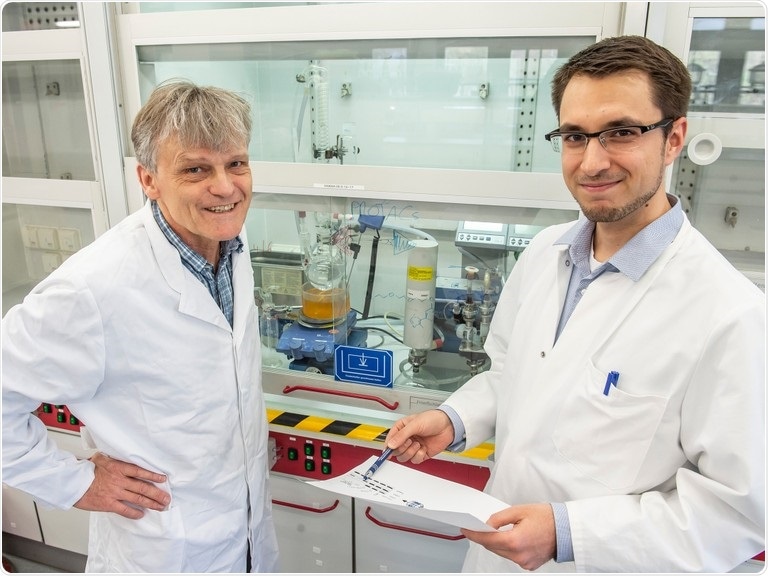An international study, headed by the University of Bonn and Ulm University, has analyzed how the “protein shredder” of a cell can be particularly programmed to combat cancer.

Numerous synthesis steps have to be carried out until a PROTAC molecule is produced (in the background). Prof. Dr. Michael Gütschow (left) and Christian Steinebach (right) from the Pharmaceutical Institute at the University of Bonn discussing the data. Image Credit: © Barbara Frommann/Uni Bonn.
The scientists eventually showed how proteins that are highly active in breast cancer—for instance—are destroyed. The results were published in the popular journal, Chemical Science.
To perform their functions in the body, cells have to constantly generate proteins, and any protein molecules that are no longer required, are given a “disposal sticker.” All proteins that carry this label are subsequently destroyed and recycled by the proteasome, the cell’s own shredder.
For a few years, scientists have been attempting to selectively exploit this mechanism in the fight against numerous diseases, including cancer. After all, certain proteins are also needed by tumor cells.
If a disposal label could be attached to such proteins, they would certainly be shredded by the proteasome, which would further prevent the growth of the tumor cell.
Undoubtedly, this method has shown to be effective in the test tube. In this study, the researchers utilized the so-called proteolysis targeting chimeras or PROTACs for short.
However, producing these substances is very complicated. We have investigated which strategies are promising in this respect and how particularly effective PROTACs can be customized, so to speak.”
Dr Michael Gütschow, Professor, Pharmaceutical Institute, University of Bonn
Molecular hybrids
PROTACs are essentially molecular hybrids: They comprise a molecular part that docks to the cancer protein and also a structure that can attach to the labeling enzymes.
A type of arm links both these units. Thus, PROTACs bring the labeling machine and the target protein together, making sure that the destructive protein is assigned a disposal label.
We have synthesized many molecules, among other things to find out what structure and length the arm must have in order to label the protein as effectively as possible.”
Christian Steinebach, Pharmaceutical Institute, University of Bonn
The scientists also improved another feature of the PROTACs. Every cell has dozens of different labeling enzymes, known as ubiquitin ligases, but all these enzymes do not work equally well with each protein.
“We have therefore produced and tested different PROTACs for different ligases,” stated Dr. Jan Krönke from Ulm University Medical Center.
The developed active substances target a protein that makes sure that the multiplication of cancer cells occurs in a more optimal manner. Currently, the PROTACs cause the cell’s own shredder to degrade the protein.
In experiments with cell cultures, we were able to show that our PROTACs actually significantly reduce the cellular concentration of this protein and effectively suppress the growth of cancer cells. The substances now allow us to study proteins that are important for the tumor in more detail.”
Dr Jan Krönke, Ulm University Medical Center
Ulm University and the University of Bonn are among the top institutions in Germany in the new field of PROTAC research.
“Our study shows prototypically which techniques can be used to produce and specifically optimize these active substances,” added Gütschow.
Such strategies are attracting a great deal of interest because PROTACs are considered a crucial beacon of hope for treating many serious diseases.
Source:
Journal reference:
Steinebach, C., et al. (2020) Systematic exploration of different E3 ubiquitin ligases: an approach towards potent and selective CDK6 degraders. Chemical Science. doi.org/10.1039/d0sc00167h.